
Mayhem 7's is the brain-child of Coach Ry Akana. Coach Ry is the President and owner of Akana Athletics, LLC and QBFG Academy. He has been a high school football coach for the last 30 years, and is currently the offensive coordinator and QB's coach at Rainier Beach H.S in Seattle, WA.
The concept of Mayhem 7's was developed over the many years that Coach Ry spent coaching high school football, and the time he spent training young quarterbacks. He was frustrated with the lack of realistic quarterback work his quarterbacks received, particularly in the off-season, when high school teams can really only participate in organized 7 on 7 passing leagues. When they returned for fall camp, he noticed that his quarterbacks had developed bad habits in their footwork and pocket awareness over the summer and had to spend valuable fall
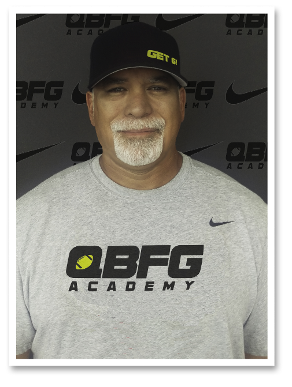
camp time working to reset their feet and correcting their pocket limitations. He frowns upon the 7 on 7 format, as it pertains to the quarterback position, and cites that the traditional format of 7 on 7 is not very conducive or realistic for the quarterback. Very rarely ever, does the quarterback have the luxury of sitting comfortably in the pocket for four seconds, making uncontested throws with no pressure or any sensation of chaos around him! He feels that it did more damage to his quarterbacks, because it gave them a false sense of security in the pocket.
Coach Ry started to add simulations of pressures in his pass offense/pass defense periods in practice, in order to give his quarterbacks more quality work in the pocket, making better decisions with the football, and developing escape methods from different angle pressures. What evolved from these drills, is the basis of the "Mayhem 7's" format.
Simply put, Mayhem 7's is the traditional 7 on 7 format, with a live rush on the quarterback on every play. Pressures come from designated rushers on the line of scrimmage. The drill is designed to accelerate the QB I.Q, help the QB make better and quicker decisions on where to throw the ball, develop his escape tools out of the pocket (Yes, Mayhem 7's does allow for the QB to break the pocket and extend the play before the expiration of the 4 second timer). The only rule on the Mayhem 7's extended play, is that the QB can only run toward the sideline, in the direction that he broke out of the pocket. He is then attempting to complete a pass on the run.
"Statistics have proven that the success rate for scoring touchdowns and converting first downs, increase exponentially, if your quarterback can extend plays outside the pocket." - Bill Polian, NFL analyst for ESPN
As the Mayhem 7's format now gives the quarterback the ability to extend the four second play, receivers now need to be adept in their routes. "Scramble" rules are now in effect; coming back to the quarterback if you were going vertical, going left if you were going right, going vertical if you were coming back or sitting, or finding open spaces on the field to sit in.
Defensively, the defense now has to more proficient at covering receivers on extended plays. They need to be able to be more explosive on 'start-and-stop' movements laterally and vertically, to recovering from the receivers scramble rule. Comprehensively, Mayhem 7's is a format that gives everyone involved on the playing field, offensively and defensively, better quality work and a more realistic look at game like situations.

FIELD SET UP & POSITIONING
Below, is how the field is set up for a Mayhem 7's game. Each game has (1) one official timer, and (2) two referees. One referee is positioned on the line of scrimmage, and the other is positioned in the defensive secondary. The official timer is positioned behind the offense. The offensive coach also stands behind the offense to select the "Rusher" of choice, on each down.
The Mayhem 7's format is set up with (4) four defensive rushers (See Fig. 1):
• #2 & #3 - Aligned in "1" or "3" techniques. They are the dual A & B gap rushers
• #1 & #4 - Aligned in "5" or "9" techniques. They are the dual C & D gap rushers
Rushers are trained by the Mayhem 7's staff to execute their roles. In our effort to make this as realistic as possible, rushers need to have their rush timing right, their path to the QB correct (See Fig. 2), and what they do to the QB when they are assigned as the "live" rusher. Each rusher is equipped with a pool noodle and a hand shield, which act as aids in their roles on each play or down.
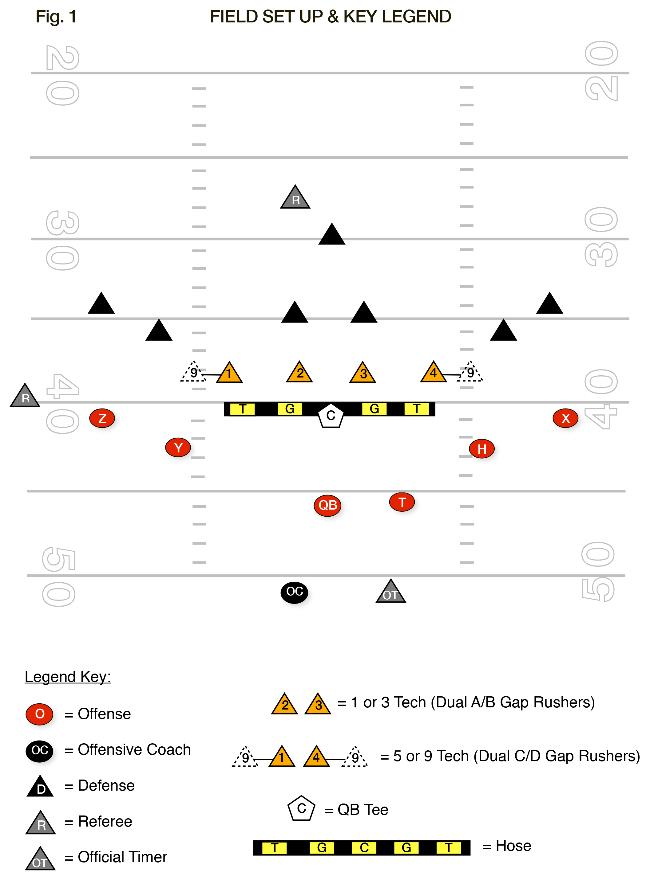
Rushers belong to the Mayhem 7's team and are trained to simulate an accurate rush on the quarterback. The path to the quarterback is crucial to helping quarterbacks tie their eyes from the rushers through to the defenders and receivers. The defensive lineman never have a straight-line to the quarterback. The protection from the offensive lineman pushes the rushers out, to create a safe pocket for the quarterback. So, it is important that our rushers take the same arc line to the quarterback.
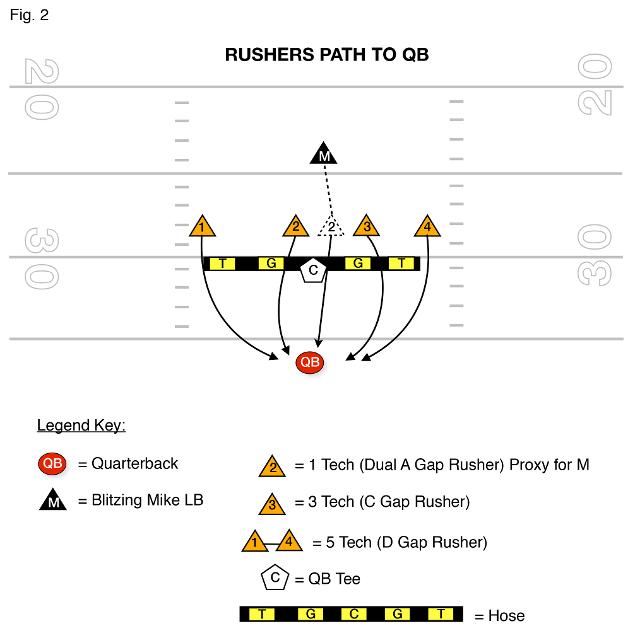
POOL NOODLE
As crazy as it may sound, the pool noodle is used in the Mayhem 7's format to provide a type of physical distraction to the QB. It helps him develop his pocket sensory skills.
When a rusher has the assignment to rush the quarterback, he uses the noodle to gently tap the QB, around the vicinity of his upper torso (shoulders, arms, back) before he throws the ball. We try to simulate for the QB, as best we can, an array of hand grabs and arm swats that he'll feel around him, sitting in the pocket. If the QB decides to break the pocket, the live rusher chases him toward the sideline, while continuing to strike him with the noodle. This
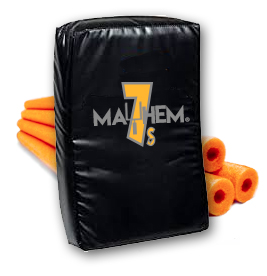
gives the quarterback an added element of urgency while being pursued, and having to be accurate while throwing on the run. It's really not as easy as it sounds! Each rusher is armed with a hand shield pad, and a pool noodle. They are effective tools in creating a simulated sensation of chaos and duress, which greatly enhances and develops the QB's pocket sensory and awareness skills. Get comfortable being uncomfortable!
HAND SHIELD PAD
When you hear football commentators during a game say, "Wow, he really took a shot after that throw!" They are referring to the quarterback getting hit by a blitzing linebacker. We teach our quarterbacks to stand in the pocket, until receivers can get separation from a defender, to deliver a pass. What we don't prepare our quarterbacks for, is the inevitable shot they will take from that blitzing linebacker! Mayhem 7's tries to re-create that hit on the quarterback, by arming the designated rushers with a hand shield pad. The live rusher uses the hand shield pad to deliver a shot on the quarterback upon making his throw.

THE GAME STRUCTURE
To be absolutely certain that you are getting the maximum benefit from participating in the Mayhem 7's format, it's imperative that the quarterback coach, the offensive coordinator, or the passing game coordinator proficiently trains their quarterback in these three areas:
1. Where he goes with the football based on;
• A gap pressure by rushers #2 or #3 (in 1 tech alignment) or,
• A gap immediate blitz by a linebacker (Proxy blitzers #2 or #3)
• B gap pressure from the rushers #2 or #3 (in 3 tech alignment)
• C gap pressure from rushers #1 or #4 (in 5 tech alignment) or,
• D gap Immediate blitz by a defensive back (Proxy blitzers #1 or #4 in a 9 tech align.)
2. Able to utilize evasion techniques from all pressures, and throw from within the pocket
3. Know how to bail and escape the pocket from B, C & D gap pressures when receivers are covered, and be able to throw on the run while moving toward the sideline.
A quarterback will NOT have time to think about how he will handle different pressures once the play begins. He needs to be thinking about his progressions, reading defenses, and getting the ball out of his hands in 4 seconds. Reaction to pressures need to be handled intuitively as second nature instinct. To accomplish that, he needs to be equipped with the knowledge and skill set of how to escape the pocket from each of these pressures, and be able to throw on the run. These skills needs to be practiced and heavily repped in order to be successful in this format.
As in the traditional 7 on 7 game, the ball starts on the 40 yd. line going in. After the offense breaks the huddle, the offensive coach or coordinator points to (1) one rusher to be the live rusher. On the snap of the ball, all 3 rushers (with the exception of rushers #2 or #3 on an A gap blitz, or rushers #1 or #4 on a D gap blitz) must delay for a two second count. After the two second count, ALL rushers take two hard steps up field, and only the 'live' rusher continues his path to the quarterback. As he approaches the QB, he begins to frap him with the pool noodle, then delivers a shot with the hand shield to the QB as he makes his throw. The other 3 rushers drop their noodles and hand shields, raise their arms over their heads to interfere with the throwing lanes of the QB.
On the A gap blitz, the Mike or Will linebackers have the option to show or not show pre-snap blitz. On the snap, either M or W will take a knee at rusher #2 or 3's spot (1 tech) and is NOT involved in the rest of the play. Proxy rusher #2 becomes the immediate rusher to the QB.
Below is an example of an A gap immediate blitz for the Mike backer, executed by proxy rusher #2.
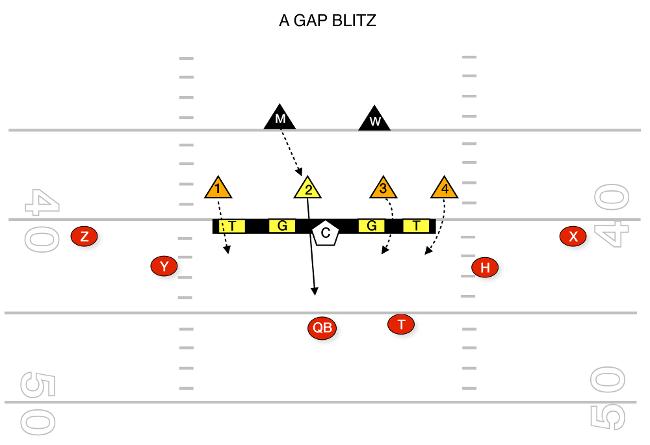
*Proxy rusher #2 does NOT delay 2 seconds on the A gap blitz, he comes immediately on the snap!
If the result of the play ends up in pass completion; the line ref's job is to set the new L.O.S spot. Rushers 1, 2 & 4 move the hose to the new L.O.S. Rusher #3 is responsible to move and set the QB tee. Once it is set, the official timer blows his whistle and starts the 24 second clock.
If it is an incomplete pass; the line ref sets the ball on the QB tee, and the official timer blows his whistle and starts the 24 second clock and declares the down.
Below is an example of an A gap rush, by rusher #2 (in a 1 tech alignment)
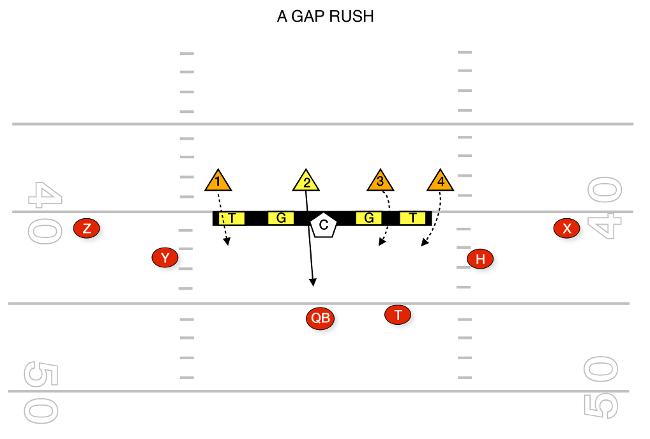
Rusher #2 does delay 2 seconds on the A gap rush, no linebacker blitz
After the two second count, ALL rushers take two hard steps upfield. Rusher #2, the 0 tech 'live' rusher continues his path to the quarterback, striking the QB with the noodle and delivering a shot with the hand shield as QB makes his throw. The other 3 rushers drop their noodles and hand shields, raise their arms over their heads to interfere with the throwing lanes of the QB.
If the result of the play ends up in pass completion; the line ref's job is to set the new L.O.S spot. Rushers 1, 2 & 4 move the hose to the new L.O.S. Rusher #3 is responsible to move and set the QB tee. Once it is set, the official timer blows his whistle and starts the 24 second clock.
If it is an incomplete pass; the line ref sets the ball on the QB tee, and the official timer blows his whistle and starts the 24 second clock and declares the down.
Below is an example of the B gap rush call by the rusher #3 (3 tech).
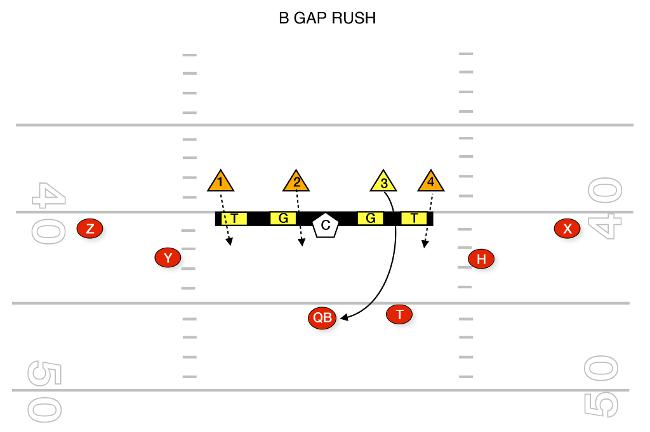
Rusher #3 is the 'live' B gap rusher. He simulates his path to the QB, as if being blocked by the right guard. It is NOT a direct line to the QB.
After the two second count, ALL rushers take two hard steps upfield. Rusher #3, the 3 tech 'live' rusher continues his path to the quarterback, striking the QB with the noodle and delivering a shot with the hand shield as QB makes his throw. The other 3 rushers drop their noodles and hand shields, raise their arms over their heads to interfere with the throwing lanes of the QB.
If the result of the play ends up in pass completion; the line ref's job is to set the new L.O.S spot. Rushers 1, 2 & 4 move the hose to the new L.O.S. Rusher #3 is responsible to move and set the QB tee. Once it is set, the official timer blows his whistle and starts the 24 second clock.
If it is an incomplete pass; the line ref sets the ball on the QB tee, and the official timer blows his whistle and starts the 24 second clock and declares the down.
Below is an example of a C gap rush call by rusher #4 (5 tech).
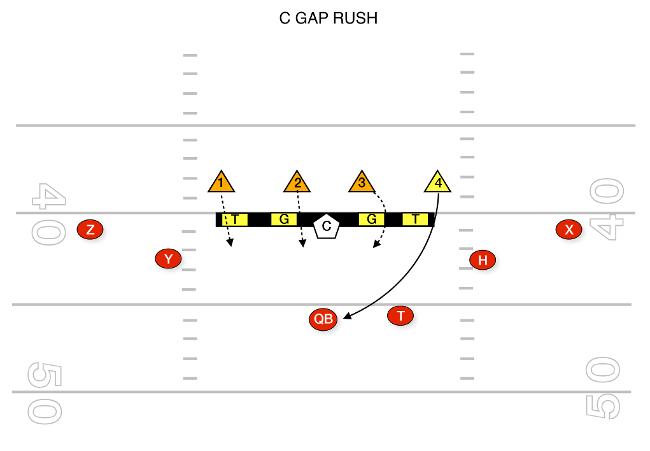
Rusher #4 is the 'live' 5 tech rusher. #4 simulates his path to the QB, as if being blocked by the left tackle.
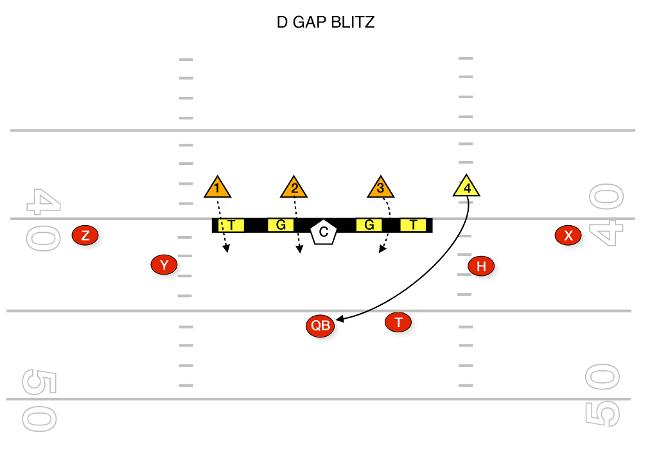
Rusher #4 is the 'live' 9 tech rusher. #4 simulates an immediate safety blitz.
After the two second count, ALL rushers take two hard steps upfield. Only rusher #4, the 5 tech 'live' rusher continues his path to the quarterback, striking the QB with the noodle and delivering a shot with the hand shield as QB makes his throw. The other 3 rushers drop their noodles and hand shields, raise their arms over their heads to interfere with the throwing lanes of the QB.
If the result of the play ends up in pass completion; the line ref's job is to set the new L.O.S spot. Rushers 1, 2 & 4 move the hose to the new L.O.S. Rusher #3 is responsible to move and set the QB tee. Once it is set, the official timer blows his whistle and starts the 24 second clock.
If it is an incomplete pass; the line ref sets the ball on the QB tee, and the official timer blows his whistle and starts the 24 second clock and declares the down

WHAT THE QUARTERBACK NEEDS TO KNOW TO BE SUCCESSFUL
There are two facets pertaining to the Mayhem 7's format, that a QB needs to really know and understand to be successful. One, is being able to successfully get a throw off from within the pocket, while evading and being harassed by the live rusher from the A, B, C, or D gaps. Second, is the QB's option to escape the pocket and extend the play beyond the 4 second timer, making a throw on the run, while moving toward the sideline. This, in essence, is what makes Mayhem 7's uniquely different from the traditional 7 on 7.
1. EVADE & THROW FROM WITHIN THE POCKET
Successful quarterbacks are one's that demonstrate patience in the pocket, run through all their progressions, and deliver strikes amidst the chaos around them. Mayhem 7's is the perfect way to condition and train a quarterback to accomplish those tasks. Anybody can be perfect under zero pressure and no distractions!
Let's begin with how we teach QB's to evade the A gap immediate blitzer, and the best option to throw to.
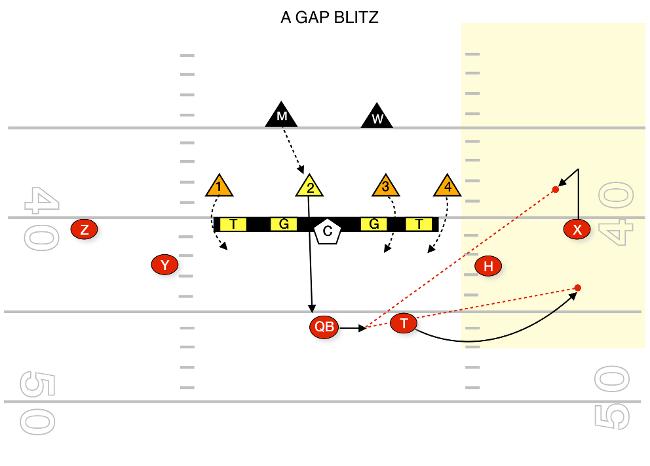
The QB steps away from the A gap blitzer, and throws away from pressure
In handling the A gap immediate rush (linebacker blitz); your QB should have answers, pre-snap, for the following;
1. Who is hot?
2. 1-on-1 matchup of his best outside receiver
At pre-snap, if the QB detects an immediate rush by the Mike or Will linebackers, he will communicate to his receivers opposite the blitz, that he will throw HOT to their side. On the snap, QB drops, steps away from pressure and throws to a hot receiver in the shaded area.
If the result of the play ends up in pass completion; the line ref's job is to set the new L.O.S spot. Rushers #1 & #4 move the hose to the new L.O.S. Rusher #3 is responsible to move and set the QB tee. Once it is set, the official timer blows his whistle and starts the 24 second clock.
If it is an incomplete pass; the line ref sets the ball on the QB tee, and the official timer blows his whistle and starts the 24 second clock and declares the down.
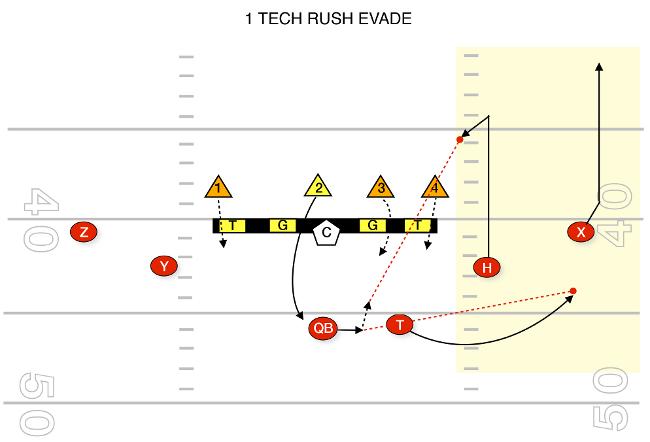
The QB steps away from the 1 tech rusher, and throws away from pressure
This throw is not as immediate as the unblocked LB blitz, but the QB still needs to get the ball out quickly. He needs to know where the quick routes, opposite A gap pressure, are. On the snap, QB drops, steps away from pressure and throws to a hot receiver in the shaded area.
If the result of the play ends up in pass completion; the line ref's job is to set the new L.O.S spot. Rushers #1 & #4 rushers move the hose to the new spot. Rusher #3 is responsible to move and set the QB tee. Once it is set, the official timer blows his whistle and starts the 24 second clock.
If it is an incomplete pass; the line ref sets the ball on the QB tee, and the official timer blows his whistle and starts the 24 second clock and declares the down.
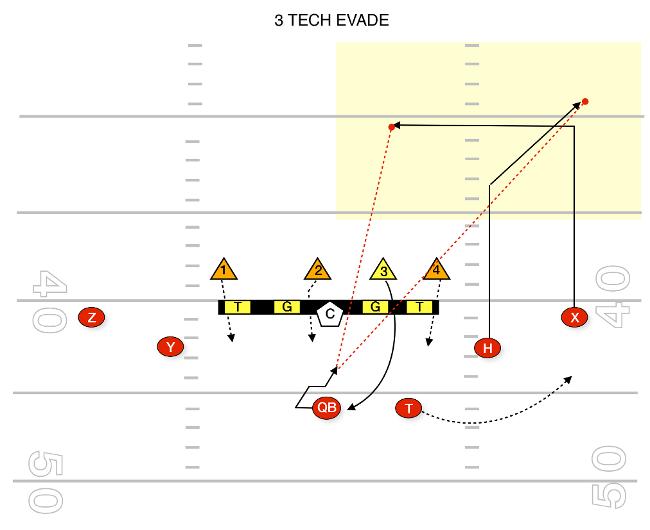
The QB dips his back shoulder through the reaching paws of the 3 tech rusher, hitches up in the pocket and looks for an open receiver
Now, let's address the 3 tech rusher, and how we evade his rush and throw from the pocket. On the snap, QB drops and reads through his progression. As the 3 tech rusher gets "QB high" (even to the QB), the rusher begins frapping the QB with the pool noodle. The QB dips his back shoulder through the reach of the 3 tech rusher, hitches up in to the pocket, looking to throw to an open receiver in the shaded area. If no receiver is open, QB tucks the ball and runs, and the play is dead. If the QB gets the ball off before the 4 second timer expires, the rusher gives him a pop with his hand shield pad, simulating the live game sensation of being hit as you throw the ball.
If the result of the play ends up in pass completion; the line ref's job is to set the new L.O.S spot. Rushers #1 & #4 move the hose to the new spot. Rusher #2 is responsible to move and set the QB tee. Once it is set, the official timer blows his whistle and starts the 24 second clock.
If it is an incomplete pass; the line ref sets the ball on the QB tee, and the official timer blows his whistle and starts the 24 second clock and declares the down.
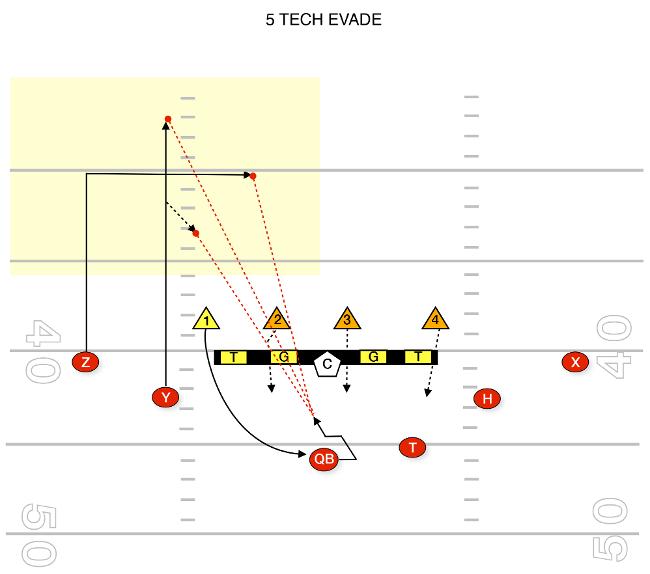
The 5 tech 'live' rusher simulates his path to the QB, as if being blocked by the left tackle.
Now, let's address the 5 tech rusher, and how we evade his rush and throw from the pocket. On the snap, QB drops and reads through his progression. As the 5 tech rusher gets "QB high" (even to the QB), the rusher begins frapping the QB with the pool noodle. The QB "S-hitches" up in to the pocket, looking to throw to an open receiver in the shaded area. If no receiver is open, QB tucks the ball and runs, and the play is dead. If the QB gets the ball off before the 4 second timer expires, the rusher gives him a pop with his hand shield pad, simulating the live game sensation of being hit as you throw the ball.
If the result of the play ends up in pass completion; the line ref's job is to set the new L.O.S spot. Rushers #2 & #4 move the hose to the new spot. Rusher #3 is responsible to move and set the QB tee. Once it is set, the official timer blows his whistle and starts the 24 second clock.
2. ESCAPING THE POCKET AND THROWING ON THE RUN
This is where Mayhem's becomes exciting and which truly separates it from the traditional 7 on 7 format! Where the traditional 7 on 7 ends for the quarterback at the 4-second timer, Mayhem 7's has the option for the quarterback to extend the play, by escape the pocket and extend the play beyond the 4-second timer. There are only two rules that apply, if the quarterback escapes the pocket;
1. The quarterback must make a clear attempt to escape the pocket, prior to the expiration of the 4-second timer. As he escapes the pocket, the official timer sounds the airhorn.
2. The quarterback must continually move toward the direction of sideline that he escaped from (Right or Left), and must make a throw on the run before he steps out of bounds. There is no stopping to set up, and no reversing field..
This is also the point where everyone on the field, offensively and defensively, gets additional quality work in. As the airhorn sounds;
• Offensively, receivers and running backs now work on "scramble rules" to get open for the quarterback. Vertical routes come back to the QB, underneath routes turn up field and go. crossing routes reverse field and find open areas to sit in.
• Defensively, they must now engage and adjust to the offensive scramble rules. If in man coverage, they'll need to stick with their man, communicate amongst themselves if passing off receivers. If playing zone, they need to find receivers who are crossing or settling in their coverage area.
Let's begin with the A gap pressure rusher (#2), in the 1 tech alignment.
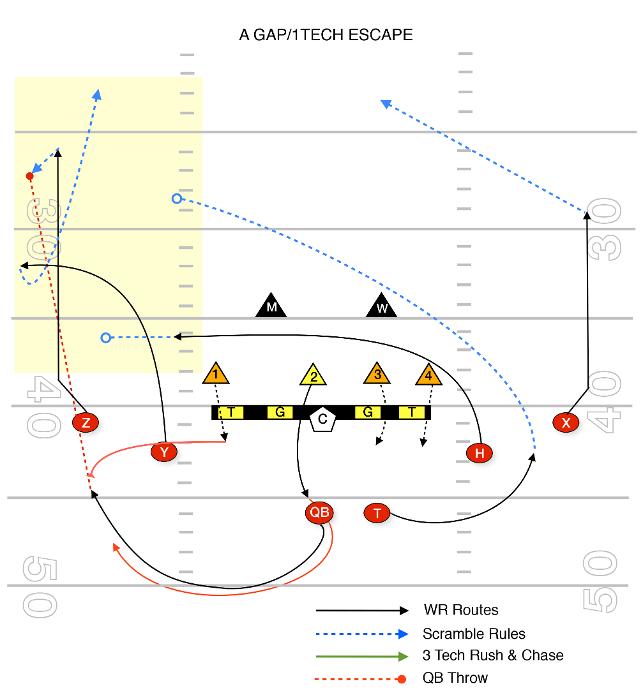
Not a high percentage escape from this pressure, but keep it in your tool belt! QB reverses out the back door the same side the pressure comes from, gets 2-3 yds. depth, then must find an open receiver while running toward the sideline.
Let's start off with the escape method from an A gap rusher. This is not a high percentage escape method off this pressure, but keep it in your tool belt. It will be most successful off an over-exuberant linebacker who sees a clear shot at you, and approaches you like an out-of-control freight train!
QB ESCAPE / THROW ON THE RUN
On the snap, QB drops and sees the immediate linebacker blitz. QB allows the blitzer to approach within a yard of him, then reverses out (to the same side of the pressure), gets 3-4 yds. depth, gets his front shoulder turned upfield, and looks for an open receiver while running toward the sideline. The QB cannot stop and set up to throw once he leaves the pocket.
EXTENDED PLAY SIGNAL
As soon as the QB breaks the pocket, the official timer sounds an air horn. The air horn alerts the receivers and the defense that the QB has bailed the pocket. Receivers go into their scramble rules (Going long; coming back, Short route; Go long, Breaking in; break out). Defense must adjust to the scramble rules. If in man coverage, they'll need to stick to their man. If playing zone, they need find open receivers and cover area.
*Dotted lines indicate the scramble rules from the original route run by receivers
BLITZER & RUSHERS
The A gap blitzer runs down the QB with the pool noodle, and delivers body strikes to him, giving him a sense of pursuit pressure. The 5 tech rusher (#1 or #4, to the side that the QB escapes) is allowed to attack the QB from the front (simulating a DE) and deliver a hand shield blow as the QB makes his throw.
PLAY RESULT
If the result of the play ends up in pass completion; the line ref's job is to set the new L.O.S spot. Rushers #1 & #4 move the hose to the new spot. Rusher #2 or #3 are responsible to move and reset the QB tee. Once it is set, the official timer blows his whistle and starts the 24 second clock. If no receiver is open, QB must run out-of-bounds at the sideline, and the play is dead. If it is an incomplete pass; the line ref sets the ball on the QB tee, and the official timer blows his whistle and starts the 24 second clock and declares the new down.
Now let's look at the B gap escape on the 3 tech alignment rush.
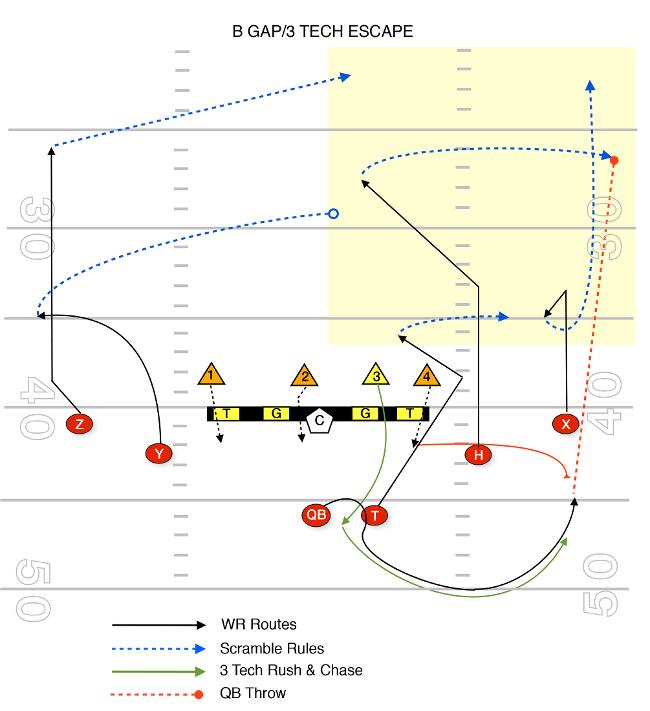
The B gap escape comes under and around the 3 tech rusher. QB gets depth out of the pocket, turns his front shoulder downfield and looks for an open receiver
This is how we teach our QB's to escape from the B gap pressure from the 3 tech rusher.
QB ESCAPE / THROW ON THE RUN
On the snap, QB drops. On the two second count, all rushers take two hard steps upfield. Only the live rusher (#3/3 tech) continues to the QB. #3 takes an arc angle to the QB, as if being blocked by the right guard. As the 3 tech gets even with the QB, the QB ducks under and around the 3 tech, gets 4-5 yds. depth, gets his front shoulder turned upfield and looks for an open receiver, while moving toward the sideline.
EXTENDED PLAY SIGNAL
As soon as the QB breaks the pocket, the official timer sounds an air horn. The air horn alerts the receivers and the defense that the QB has bailed the pocket. Receivers go into their scramble rules (Going long; coming back, Short route; Go long, Breaking in; break out). Defense must adjust to the scramble rules. If in man coverage, they'll need to stick to their man. If playing zone, they need find open receivers and cover area.
*Dotted lines indicate the scramble rules from the original route run by receivers
BLITZER & RUSHERS
The B gap rusher runs down the QB with the pool noodle, and delivers body strikes to him, giving him a sense of pursuit pressure. The 5 tech rusher (#4), to the side that the QB escapes, is allowed to attack the QB from the front (simulating a DE) and deliver a hand shield blow as the QB makes his throw.
PLAY RESULT
If the result of the play ends up in pass completion; the line ref's job is to set the new L.O.S spot. Rushers #1 & #4 move the hose to the new spot. Rusher #2 or #3 are responsible to move and reset the QB tee. Once it is set, the official timer blows his whistle and starts the 24 second clock. If no receiver is open, QB must run out-of-bounds at the sideline, and the play is dead. If it is an incomplete pass; the line ref sets the ball on the QB tee, and the official timer blows his whistle and starts the 24 second clock and declares the new down.
Now let's look at the C gap escape on the 5 tech alignment outside rush.

The C gap escape comes from the 5 tech rusher. QB makes an "influence" step with his front foot and shoulder to get the 5 tech to bite up in the pocket, the reverses out the back door
This is how we teach our QB's to escape the C gap pressure of the 5 tech outside rusher.
QB ESCAPE / THROW ON THE RUN
On the snap, QB drops. On the two second count, all rushers take two hard steps upfield. Only the live rusher (#1/5 tech) continues to the QB. #3 takes an arc angle to the QB, as if being blocked by the left tackle. As the 5 tech gets even with the QB, the QB makes an "influence" step with his front foot and shoulder to get the 5 tech to move up in the pocket. QB then reverses out the back door, gets 4-5 yds. depth, gets his front shoulder turned upfield and looks for an open receiver, while moving toward the sideline.
EXTENDED PLAY SIGNAL
As soon as the QB breaks the pocket, the official timer sounds an air horn. The air horn alerts the receivers and the defense that the QB has bailed the pocket. Receivers go into their scramble rules (Going long; coming back, Short route; Go long, Breaking in; break out). Defense must adjust to the scramble rules. If in man coverage, they'll need to stick to their man. If playing zone, they need find open receivers and cover area.
*Dotted lines indicate the scramble rules from the original route run by receivers
BLITZER & RUSHERS
The C gap rusher runs down the QB with the pool noodle, and delivers body strikes to him, giving him a sense of pursuit pressure. The 1 tech rusher (#2), to the side that the QB escapes, is allowed to attack the QB from the front (simulating a DE) and deliver a hand shield blow as the QB makes his throw.
PLAY RESULT
If the result of the play ends up in pass completion; the line ref's job is to set the new L.O.S spot. Rushers #1 & #4 move the hose to the new spot. Rusher #2 or #3 are responsible to move and reset the QB tee. Once it is set, the official timer blows his whistle and starts the 24 second clock. If no receiver is open, QB must run out-of-bounds at the sideline, and the play is dead. If it is an incomplete pass; the line ref sets the ball on the QB tee, and the official timer blows his whistle and starts the 24 second clock and declares the new down.
© 2022 All Rights Reserved. Akana Athletics, LLC, P.O Box 7451, Bellevue, WA 98008